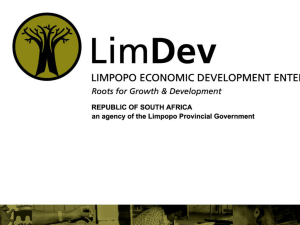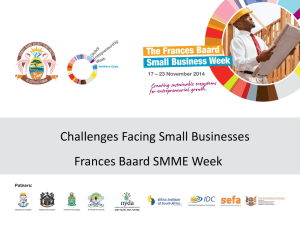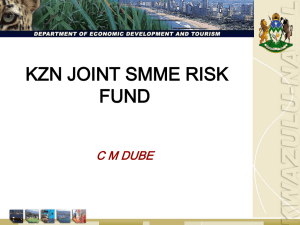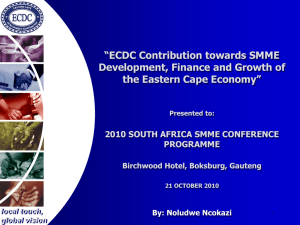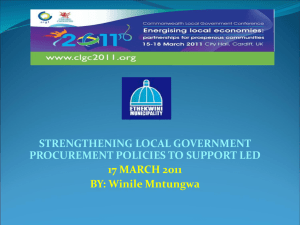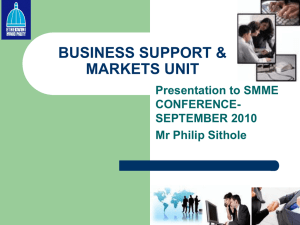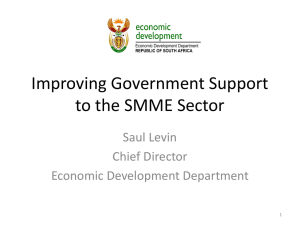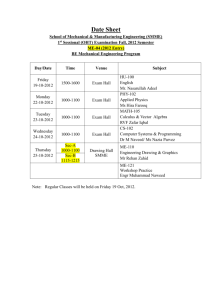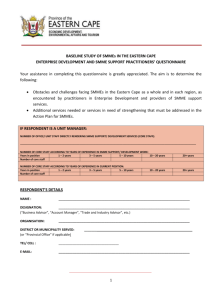SMME Strategy - Nelson Mandela Bay Municipality
advertisement
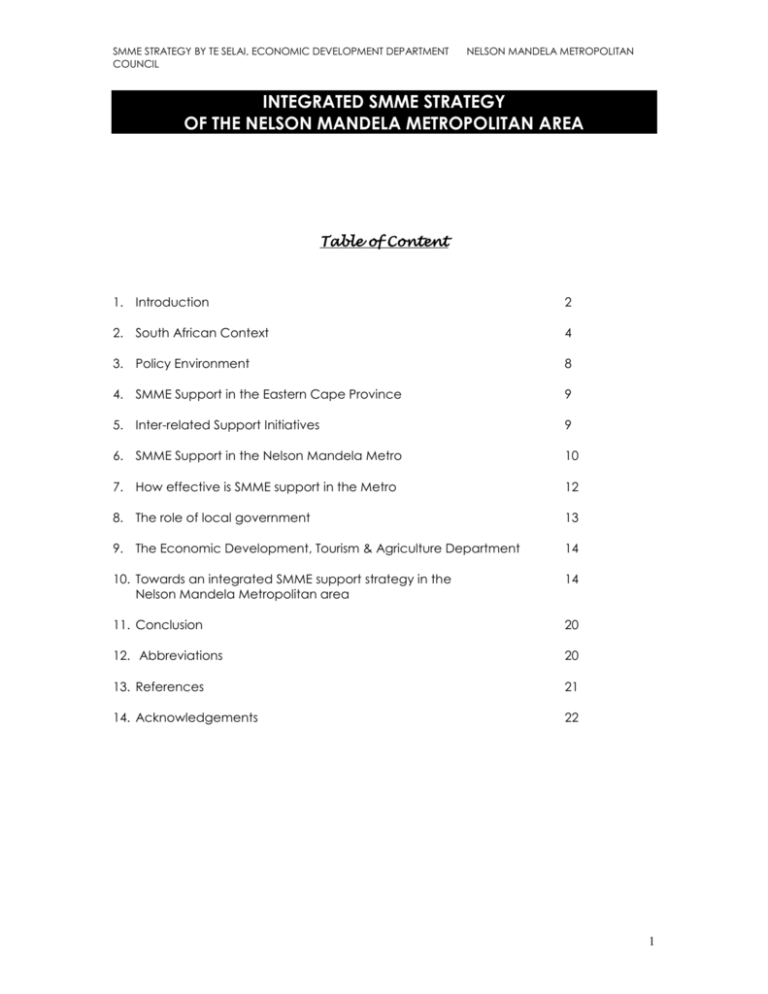
SMME STRATEGY BY TE SELAI, ECONOMIC DEVELOPMENT DEPARTMENT COUNCIL NELSON MANDELA METROPOLITAN INTEGRATED SMME STRATEGY OF THE NELSON MANDELA METROPOLITAN AREA Table of Content 1. Introduction 2 2. South African Context 4 3. Policy Environment 8 4. SMME Support in the Eastern Cape Province 9 5. Inter-related Support Initiatives 9 6. SMME Support in the Nelson Mandela Metro 10 7. How effective is SMME support in the Metro 12 8. The role of local government 13 9. The Economic Development, Tourism & Agriculture Department 14 10. Towards an integrated SMME support strategy in the Nelson Mandela Metropolitan area 14 11. Conclusion 20 12. Abbreviations 20 13. References 21 14. Acknowledgements 22 1 SMME STRATEGY BY TE SELAI, ECONOMIC DEVELOPMENT DEPARTMENT COUNCIL NELSON MANDELA METROPOLITAN INTEGRATED SMME STRATEGY OF THE NELSON MANDELA METROPOLITAN AREA Prepared at the Economic Development Unit, Port Elizabeth Municipality 1. INTRODUCTION The role played by small businesses is being increasingly recognized all-over the world. The perceived potential of small businesses to create employment has caused governments in many countries to pay the small business sector more attention. Although, almost everywhere, results have not matched expectations, available evidence indicates that the sector contributes meaningfully to economic growth, social development, and employment provision. In the European Union, for example, the small business sector accounts for much of total employment, and a large portion of the total gross domestic product (Ntsika, 1998). A factor of major importance, for the transformation of South African society, is job creation, wealth generation and improved standards of living for all South Africans. High unemployment rate and poor socio-economic conditions have highlighted the need for reconstruction and development. The existing large firms and public sector have been unable to cope with solving these problems and hence the focus has been placed on the small business sector as an intricate part of solving the economic crisis (Business Development Services, 1996) The White Paper on a National Strategy for the development and promotion of small business in South Africa states: “The stimulation of small, medium and micro enterprises must be seen as part of an integrated strategy to take the South African economy onto a higher road – one on which is diversified, productivity enhanced, investment is stimulated and entrepreneurship flourishes” (Ntsika, 1997). As stated in the National Strategy for the development and promotion of small business in South Africa, the creation of an enabling environment for the development of small businesses needs to happen at both national and a local level. On a local level, opportunities and resources need to be identified and utilized in a way that takes into account the local characteristics and resources (Ntsika, 1997). Thus, the developmental role of local government has undergone a transformation, in terms of which local government has come to be seen as a key agent of economic development. These development initiatives place increasing emphasis on the small, medium and micro enterprise sector and how to strengthen it; and SMME support increasingly becoming a local (rather than national or provincial) priority. 2 SMME STRATEGY BY TE SELAI, ECONOMIC DEVELOPMENT DEPARTMENT COUNCIL NELSON MANDELA METROPOLITAN WHY STRATEGIC SUPPORT FOR SMME ‘s The case for employment creation and wealth distribution through small business is based on sound economic sense. Small businesses have been identified as labour-intensive, have the need for little capital and make use of the local resources available. By channeling these resources to the small business sector, particularly in a growing and developing economy like South Africa’s, employment opportunities can be maximized and people are given the opportunity to contribute to the development of the economy. A research conducted by Ntsika identified that the small business sector contributes approximately 32.7% to South Africa’s gross domestic product (GDP). In fact, in 1998, the small business sector accounted for about 41% of the country’s gross domestic product. Governments worldwide have assisted SMME ‘s for various reasons, which include: ► ► ► ► ► ► ► ► ► ► ► ► SMME ‘s have shown a remarkable capacity to absorb labour, albeit largely unskilled. In 1997, the small business sector’s contribution to employment in South Africa amounted to 50.3% (Ntsika, 1998). SMME ‘s are usually locally owned and controlled, and can strengthen the extended family and other social systems and cultural traditions. In South Africa, where non-whites were historically discouraged from owning businesses, the first attempts are likely to be informal, small, micro or medium. SMME’ s provide a ‘nursery’ and a proving ground for entrepreneurship and innovation. The products of SMME ‘s tend to reflect local technology and are arguably more likely to satisfy the needs of poor people than are the products of large enterprises and foreign technology. Because the profits of small enterprises are not dependent on long production runs, small firms can manufacture smaller quantities of products, which have a regional or even a local market only. SMME’ s satisfy local needs not only by making differential products but also by being scattered throughout the country. This ensures a more equitable distribution of employment opportunities and that raw material producers are more likely to find local markets. Local technology is more likely to use locally produced raw material and equipment, saving foreign exchange. SMME ‘s provide employment for and sometimes expand the entrepreneurial talents of women. SMME ‘s tend to use less capital, a scarce resource, than large firms. They also (arguably) require appropriate management skills, which are scarce in Third World situations. Comparative studies of large and small businesses, carried out in countries at all stages of development, confirm that small firms generally employ more labour per unit of capital and require less capital per unit of output, than do large ones (Harper, 1984:16). For the economy as a whole, Harper (1984:16) argues: “Small businesses are likely to be more resilient to depression and to offer a steadier level of employment than large ones; their activities and locations are diverse, they depend on a wide variety of sources and types of raw material, and their owners, if only for the want of any 3 SMME STRATEGY BY TE SELAI, ECONOMIC DEVELOPMENT DEPARTMENT COUNCIL NELSON MANDELA METROPOLITAN alternative, are likely to stay in business and maintain at least some activity and employment in conditions where foreign investors would have closed their factories”. Although it is too early to correctly assess the impact of government policy and programmes on the development of the small, medium and micro enterprises sector in South Africa, available statistics indicate that the SMME sector is already playing an important role in the South African economy. And, in all probability, its role will become crucial in the country’s socio-economic development in the years that lie ahead. 2. SOUTH AFRICAN CONTEXT 2.1 NATURE OF SMME ‘s The National Small Business Act of 1996 gives national definitions of various categories of the elements of the small business sector in South Africa. First, it notes that the enterprise must be a separate and distinct business entity, and must be managed by its owner/s. Four categories are then distinguished according to employment, turnover and assets. Essentially these are as follows (Ntsika, 1997) Defining SMME ’ s Micro-enterprises Annual turnover is less than the VAT registration limit (then R150 000); no more than 5 paid employees. These generally lack formality in terms of registration for tax, labour law, premises, or accounting procedures (e.g. minibus taxis, spaza shops, home industry). The category subsumes the survivalist group of enterprises, which generate income less than the poverty line, have no paid employees and minimal asset value. Very small Fewer than 10 paid employees, except in mining, electricity, manufacturing and construction, where the upper limit is 20. Enterprises operate on the formal market and have access to modern technology. Lower limit: self-employed e.g. artisans, professionals (Limits are rather fluid). Small Fewer than 50 employees. Enterprises are generally more established than the very small class, with more complex business practices. They have often outgrown direct supervision by the entrepreneur and developed a secondary coordinating mechanism. Medium Maximum of 100 employees, except in mining, electricity, manufacturing and construction, where the upper limit is 200. Enterprises are still owner-managed and controlled, but have more complex structure, often an additional management layer and division of labour. 4 SMME STRATEGY BY TE SELAI, ECONOMIC DEVELOPMENT DEPARTMENT COUNCIL NELSON MANDELA METROPOLITAN South Africa’s SMME sector is extremely diverse, both in terms of the goods and services produced and in the range of enterprise sizes, resources and opportunities it includes. The SMME sector encompasses a spectrum of informal and formal businesses, ranging from survivalists barely breaching the poverty line, to dynamic medium-sized enterprises with access to adequate resources and growth opportunities. 2.2 SMME ‘s, EMPLOYMENT AND ECONOMIC GROWTH IN SOUTH AFRICA Small and medium sized businesses are an important part of the economy. This is borne out by their significant contribution to GDP and employment in the country. Estimates for 1998 indicate that small enterprises accounted for 28% of GDP, and medium enterprises 13%. Together the small and medium enterprises category accounted for about 41% of GDP in 1998 (Ntsika, 1998). In 1997, small enterprises absorbed approximately 36% of total employment. Medium enterprises accounted for about 14%. Together, the small and medium enterprises’ contribution employment in the country amounted to 50.3% in 1997 (Ntsika, 1998). Based on the definitions stipulated in the Act, small enterprises are concentrated in agriculture, wholesale trade, catering and accommodation. It is also noticeable that micro enterprises are widely dispersed across sectors whilst very small firms are largely found in wholesale trade, finance and business services, catering and accommodation, manufacturing and community, social and personal services. An estimated 11% of the 836 850 enterprises in South Africa are located in the Eastern Cape Province. The figures for numbers of enterprises in all sectors are not available for Port Elizabeth-Uitenhage. East Cape figures show that 17% are survivalist, 28% are micro, 6% are small, 6% are medium and 7% are large (Ntsika, 1997). A total of 15 293 businesses were registered in 1999, with a 12% increase from 13 452 businesses in 1997 in the city of Port Elizabeth. The latest official figures show that there are 698 manufacturing enterprises registered in Port ElizabethUitenhage, 90% of which fall into the SMME category (Western District Council, 1999). Overall it is clear that the small, medium and micro enterprises (SMME) sector plays and could play an even more significant role than it currently does in terms of contribution to employment and gross domestic output, but also in helping to combat unemployment, encouraging wealth distribution and improving the quality of life for all sectors of the city’s population. 5 SMME STRATEGY BY TE SELAI, ECONOMIC DEVELOPMENT DEPARTMENT COUNCIL 2.3 NELSON MANDELA METROPOLITAN PROBLEMS FACING SMME’ s IN SOUTH AFRICA In order to develop an appropriate support framework for SMME ‘s, it is necessary to review what we know about the main problems faced by SMME ’s. While no primary research has been undertaken for this paper other than desktop research and consultations, a number of other South African studies can be drawn on to identify common problems. Key problems were discovered as follows: Financial constraints Lack of working capital is the major constraint at start-up, while a lack of investment funds becomes more significant as time passes. Savings of the owner and friends and family are still the major source of finance. Access to finance from formal lenders is scarce before a firm is at least three to five years old. There is substantial unmet demand for finance among young firms. Market constraints A lack of customers, increasing competition, and the rising cost of supplies are felt most acutely by micro-enterprises. These firms tend to operate in small, location-specific, low-income niche markets; broader markets were found to be virtually closed to them. Business premises and infrastructure The provision of basic facilities for emerging enterprises needs serious attention. These include the supply of electricity to businesses, basic services and the road infrastructure in commercial and industrial areas (Department of Trade and Industry, 1995) Laws and regulations Amongst micro-enterprises, there are municipal concerns (especially street traders), and problems with regards to health, safety, and labour codes for the workplace and taxation (Riley, 1993). Information This is an important element of empowerment for the business owner, and particularly for the emerging entrepreneur. A study in the Gauteng area in 1999, amongst 200 black entrepreneurs found that one of the most important problems is the lack of basic information, not for only small businesses, but about small businesses in the historically disadvantaged areas (Frankel, 1999). Equipment and technology The acquisition of efficient and reliable tools and access to technology represents the gap between survivalist and real sustainable expansion. It is critical that appropriate technology is developed in an effort to promote the development of smaller businesses whose owners may not possess the skills to operate more sophisticated technology. 6 SMME STRATEGY BY TE SELAI, ECONOMIC DEVELOPMENT DEPARTMENT COUNCIL 2.4 NELSON MANDELA METROPOLITAN PROBLEMS FACING SMME’S IN THE NELSON MANDELA METROPOLITAN AREA A number of surveys and research studies have been undertaken both recently and in the past five years to understand the complexity of problems faced by SMME ‘s in the Port Elizabeth – Uitenhage Metropolitan region. These studies further extend to reveal the nature and composition of SMME ‘s in this region. Some of the work done by the Institute for Development Planning and Research at the University of Port Elizabeth includes the work done in 1994 on employment creation strategies (Towards an Employment Creation Strategy for the Port Elizabeth/Uitenhage Metropole) and the reports completed in the course of 1996, namely: ► ► ► Towards identifying and encouraging black entrepreneurial potential in the Port Elizabeth Metropole The nature of black unemployment in the Port Elizabeth Metropole: What options for self-employment? The formal manufacturing sector in the Port Elizabeth Metropole: Its relationship with labour, the unemployed and the self-employed. A recent study conducted in the Port Elizabeth – Uitenhage Metropolitan region, Entrepreneurial Development Strategies in Port Elizabeth – Uitenhage was done by the Centre for Scientific and Industrial Research (CSIR) in June 1999. The study is part of a long-term process to generate information that would facilitate planning for the development of the entrepreneurial or SMME sector in the Port Elizabeth-Uitenhage region. To be precise, the main objective of the project was to investigate and make recommendations about entrepreneurial development strategies and actions plans in this region. The methodology employed in the project involved personal interviews with 65 small business support institutions, 30 small manufacturing businesses and a case study of the Community Self Employment Centre (COMSEC) in Port Elizabeth. Flaming from these studies were the following key problems: ► Lack of access to finance, i.e. lack of appropriate finance such as venture capital, start-up and bridging funding. Lack of innovative products from commercial banks and stringent lending criteria of financial institutions presents another dimension of this challenge (CSIR, 1999). ► Lack of access to markets. Accessing market and outsourcing opportunities from both private and public sector companies is identified as a problem area. This can be extended to lack of business linkages between small and big companies (CSIR, 1999) ► Inadequate access to information. Sharing of information, access to markets, opportunities and ideas as well as exposure to other service providers and SMME ‘s were some of the main perceived benefits of networking (CSIR, 1999) ► Skills development. Access to proper business and technical skills is seen as one of the greatest areas of need in the region, particularly by emerging entrepreneurs (CSIR, 1999) 7 SMME STRATEGY BY TE SELAI, ECONOMIC DEVELOPMENT DEPARTMENT COUNCIL NELSON MANDELA METROPOLITAN ► Lack of policy and co-ordination from local government. The local SMME support strategy suggested in the highest number of responses was a strategy involving co-operation, co-ordination and centralization of support provision (CSIR, 1999). ► Lack of a unified vision and support structure – causing unnecessary duplications in the support system of SMME ‘s in the region. The result is a fragmented support system that lacks capacity to deliver a meaningful, integrated holistic SMME support. 3. POLICY ENVIRONMENT 3.1 THE NATIONAL SMALL BUSINESS ACT AND INSTITUTIONS Passed in 1996 by Parliament, the act is known as the National Small Business act of 1996. It provides for (Ntsika, 1998): ► ► ► 3.2 The formal establishment of Ntsika Enterprise Promotion Agency (Ntsika) and the now defunct National Small Business Council (NSBC) as key player institutions of the national small business strategy. A structure to review the legal and regulatory environment that impacts on the development of the SMME sector; and A comprehensive and quantitative definitions of SMME ‘s and small business, differentiating between sectors and sub-sectors of the Standard Industrial Classification system. KEY PLAYER INSTITUTIONS OF THE NATIONAL SMALL BUSINESS STRATEGY The Centre for Small Business Promotion (CSBP) of the Department of Trade & Industry (DTI) and Khula Enterprise Finance Limited (Khula) are the other key institutions of the national strategy. Khula was created to form part of the implementing institutional framework of the national strategy. The CSBP concentrates on policy formulation, overseeing, monitoring and co-coordinating the national strategy, as well as co-coordinating donor funds for SMME development. Ntsika and Khula serve as implementation agencies. The former provides wholesale non-financial support services to SMME ‘s and the latter wholesale financial support services. The provincial SMME Desks were established, one for each province, to play the crucial role of ensuring provincial representation and participation, as well as grassroots involvement in the implementation of the national strategy. They were thus to work toward strengthening the bottom-up approach to service delivery. 8 SMME STRATEGY BY TE SELAI, ECONOMIC DEVELOPMENT DEPARTMENT COUNCIL NELSON MANDELA METROPOLITAN The obvious advantage of this approach is that it allows a much wider scope for grass root initiatives and diversified learning. 4. SMME SUPPORT IN THE EASTERN CAPE PROVINCE There seems to be no strategic approach that exists at a Provincial level to promote and develop the small, medium and micro enterprises in the Eastern Cape. Although an SMME Desk was established within the Provincial Economic Affairs and Tourism Ministry, no specific programmes or projects seem to have been rolled out to enhance SMME development at a provincial level. However, to address these disparities, a commitment by the provincial government to develop the SMME sector was recently affirmed by the restructuring of the provincial’s government approach to promote small business development. This has seen the merging of the government’s two delivery or implementing agencies, the Eastern Cape Development Corporation (ECDC) and the Centre for Investment and Marketing in the Eastern Cape (CIMEC), to drive SMME development at a Provincial level. The restructuring process involves developing an SMME strategy for the province of the Eastern Cape, whilst also defining roles and responsibilities of CIMEC/ECDC. Primarily, the ECDC provides loan finance to SMME ‘s, whereas CIMEC would focus on attracting direct foreign investment into the province. It is hoped that all tears of government, at regional, provincial and national levels will collaboratively work in partnership to design programmes and products that would meet needs of SMME ‘s at different levels. 5. INTER-RELATED SUPPORT INITIATIVES To avoid duplication and maximize effectiveness, local policymakers should bear in mind the possible complementary and linkages of their SMME promotion efforts with other existing policies and initiatives. In addition to the national SMME support strategy relevant initiatives include the following: ► Spatial Development Initiatives (SDI’s) and Industrial Development Zones (IDZ ‘s). The initiatives are intended to ‘unlock’ economic potential in specific areas of South Africa in order to create jobs, grow the economy of the area and contribute to restructuring ownership patterns in line with GEAR. Of relevance to the Port Elizabeth – Uitenhage Metropolitan area is the Coega IDZ and the Greater Algoa SDI, which are mooted as potential sources of opportunities for SMME ’s. ► Local Business Services Centres (LBSC’s). These are community-based or nongovernment organizations that assist SMME ‘s with various support services, varying from business advice, training, incubation of businesses and so forth. An accreditation of these institutions is done by NTSIKA. There are presently 9 SMME STRATEGY BY TE SELAI, ECONOMIC DEVELOPMENT DEPARTMENT COUNCIL NELSON MANDELA METROPOLITAN more than 30 accredited LBSC ‘s in South Africa. Four of these LBSC ‘s are located right within the Port Elizabeth – Uitenhage Metropolitan Area. ► Manufacturing Advice Centre (MAC) Programme of the Department of Trade & Industry. Two pilots MAC Centres in the form of the Durban and Port Elizabeth (PERMAC) manufacturing advice centres were established in past three years. This programme is now represented across the country. The centres work with existing entrepreneurs and assist them in areas of global competitiveness, management, finance and technical support. PERMAC is a great success story residing within the Port Elizabeth – Uitenhage Metropolitan Area. ► Business Referral and Information Network (BRAIN) of the Department of Trade & Industry is one of the very latest programmes in the market for SMME development. The programme provides a wealth of business information by means of information technology to service various SMME needs. The MAC’ s (above have been mandated to manage and further development the BRAIN system). ► Provincial Growth and Development Strategy (PGDS). One of the focal programmes of the PGDS is the enabling of local economic development, with SMME development being one of its aspects. All these initiatives illustrate national government’s determination and commitment to facilitate SMME development. It is therefore evident that local governments, such as the Nelson Mandela Metropolitan Council should attempt to emulate and embrace these efforts with programmes of their own, suited and focussed to operating environmental factors. 6. SMME SUPPORT IN THE NELSON MANDELA METRO In line with the goals of national government, it is evident that local support institutions are beginning to create a supporting environment for small enterprises, particularly those hat were previously disadvantaged by apartheid policies. In terms of the plans laid out in the White Paper, there are five local business service centres (LBSC’ s) accredited by national government in the Port Elizabeth-Uitenhage area. These are: ► ► ► ► ► Community Self Employment Centre (COMSEC) Khanya Business Development Centre (KANYA Centre) Small Business Unit of the University of Port Elizabeth (SBU) Uitenhage Self Employment Centre (USEC) Foundation for Entrepreneurship Development (FED) Of these institutions, COMSEC has the largest staff component. The most recent institution to receive full accreditation was the Small Business Unit. While in 1995 there were only two local business service centres (LBSC’ s) accredited in the city (COMSEC and KANYA Centre), the first manufacturing advisory centre, known as 10 SMME STRATEGY BY TE SELAI, ECONOMIC DEVELOPMENT DEPARTMENT COUNCIL NELSON MANDELA METROPOLITAN the Port Elizabeth Regional Manufacturing Centre (PERMAC) was launched in Port Elizabeth in 1997. PERMAC is one of the two pilot Manufacturing Advice Centres (MAC ‘s) in the country (the other being in Durban). This institution is also accredited by government and is a partnership between NTSIKA, the Council for Scientific and Industrial Research (CSIR) and the National Productivity Institute (NPI). It is aimed at providing assistance to all small, medium and micro-enterprise manufacturers in order to improve their competitiveness and growth in the market place. The objective of this organization is to provide advisory services, targeted at SMME manufacturers who have a workforce of under 200, with the aim of improving performance. The focus is on upgrading the capabilities of previously disadvantaged manufacturers. The services that they provide are as follows: ► ► ► ► ► ► Technology support Information support Business management support Marketing advice Human resources management and support Finance – access and management The only Tender Advice Centre (TAC) that is accredited by NTSIKA Enterprise Promotion Agency in the area is located at COMSEC. Most if not all of the abovementioned institutions provide non-financial support to local SMME ‘s. To address the lack of financial support institutions at the lower end of the SMME scale, a number of retail financial institutions (RFI ‘s) or intermediaries have been launched in the past three years at a local level. In fact, about 115 RFI ‘s have been started up nationally in the recent years (CSIR, 1999). Started up in the City of Port Elizabeth / Uitenhage were: ► ► ► ► ► ► ► Kwezi Small Enterprise Development Agency / Afristar (now defunct) Entrepreneurial Development SA / EDSA (now defunct) Get Ahead – Port Elizabeth Get Ahead – Uitenhage IBTT (now defunct) Business Finance Promotion Agency (BFPA) Business Partners (previously known as SBDC) Commercial and traditional banks such as FNB, STD, ABSA, NEDCOR and others also provide loan finance to SMME ‘s. The Industrial Development Corporation (IDC), with its regional offices in East London provides finance for big industrial projects and initiatives. The way that these institutions interact and respond to the problems experienced by the various levels of business are captured in models that have been developed for the local area. These models includes the MAC/LBSC model, the PERCCI SMME Task Team model, the Economic Development Unit (tentative) model and the CSIR/ COMSEC’ s Incubator model or concept. In order to understand the way in which local SMME support institutions (also known as service providers) are responding to the problems of small business, and 11 SMME STRATEGY BY TE SELAI, ECONOMIC DEVELOPMENT DEPARTMENT COUNCIL NELSON MANDELA METROPOLITAN the effectiveness of the plans that have been made in this regard (particularly by the Department of Trade and Industry), it is necessary to survey the SMME institutions in the Nelson Mandela Metropolitan area. On the other hand, a survey on SMME ‘s perceptions on the quality of support they receive is also critical. 7. HOW EFFECTIVE IS SMME SUPPORT IN THE METRO As in the case of the support institutions survey (Entrepreneurial Development Strategies in the Port Elizabeth-Uitenhage metropole, 1999), the following findings were revealed to indicate the effectiveness of support institutions: Financial. Commercial banks were sighted as being most effective in this category. The most effective institutions mentioned by the highest number of responses are Business Partners (the old SBDC) and PERMAC. This was followed by ABSA Bank, Standard Bank SME, and the two RFI’ s (Afristar and Business Finance Promotion Agency). Management. No institution providing the most effective service in this category was mentioned. However, PERMAC followed by COMSEC were mentioned as service providers in this category. Market/market research. While no institution was indicated as most effective in providing support to SMME ‘s, PERMAC was recommended by highest number of respondents. Production/technical. Once again, the highest number of responses shows that there is no institution providing the most effective support service in this category. However, PERMAC was recommended as effective in this category. Business premises. COMSEC is sighted as the most effective institution in providing this service to SMME ‘s, followed by Business Partners. Human Resources Development (training). No institution is indicated as most effective. However, PERMAC and the East Cape Training Centre (ETC) were the next highest number of mentions. In concluding, although there is vigorous support for SMME ‘s in this region, it can also be noted that the extent of support and its effectiveness thereof is an area of concern. If the CSIR report of 1999 is anything to go by (although a study to assess and evaluate each service provider in terms of capacity, outputs, impact etc is highly recommended), then it must be accepted that there exists some gaps in the current SMME support system, which could be summarized as follows (lack of): ► ► ► Wide spectrum (or effective) financial support Effective market/market research and business linkages support Effective management support 12 SMME STRATEGY BY TE SELAI, ECONOMIC DEVELOPMENT DEPARTMENT COUNCIL ► ► ► ► NELSON MANDELA METROPOLITAN Effective human resources development and training support Effective production/ technical support Effective technological support Co-ordination of SMME support The issue of capacity in terms of reaching the broad market of SMME ‘s seems to cut across in all of the above issues. The type of quality of support services provided by local SMME support institutions is another unique aspect of measuring the effectiveness of local SMME support. 8. THE ROLE OF LOCAL GOVERNMENT Subsequent the democratic local elections in 1996, greater emphasis fell on the role of local authorities in economic development. The Constitution and other legislation and policy documents have since entrenched the developmental responsibilities of local government, such that local economic development is seen as an integral component of the later ’s activities. Local Economic Development may be defined as the process or strategy in which locally based individuals or organizations use resources to modify or expand local economic activity to the benefit of the majority in the local community (Nel and Humphrys, 1999). SMME ‘s are expected to be an intricate part of local economic development strategies. The Port Elizabeth Transitional Local Council has been proactive in embracing such an approach. In its September 1997 document on “ Local Economic Development Policy”, the PE TLC clearly identifies the small, medium and microenterprises as an integral part of solving local economic challenges such as the high unemployment rates, estimated to vary between 50 – 60% and poor socioeconomic conditions in the area. Its key strategy for economic development in the Port Elizabeth area involved the establishment of the Economic Development Unit in May 2000 to implement the Council’s Local Economic Development Policy of September 1997. The responsibility of such a Unit cannot be over-emphasized as it is tasked with the responsibility of bringing economic development and policies of the Port Elizabeth Municipality into being and acting as the facilitating agency for the range of activities and projects, which also involve SMME development as one of the key thrusts. In summary, the role of the Economic Development Unit is (TechEase, August 1999): ► ► ► Strategic planning of local economic development from a local government perspective, i.e. Port Elizabeth Municipality. Development of programs and projects for LED in Port Elizabeth. Implementation of programs and projects in Port Elizabeth. 13 SMME STRATEGY BY TE SELAI, ECONOMIC DEVELOPMENT DEPARTMENT COUNCIL NELSON MANDELA METROPOLITAN An underlying approach to all three thrust is the principle of total co-operation and collaboration with all key stakeholders at a regional, provincial and national level. 9. THE ECONOMIC DEVELOPMENT, TOURISM & AGRICULTURE DEPARTMENT - NMMM It is proposed that the role of the Economic Development, Tourism & Agriculture Department, through its SMME Division be adopted by Council as follows: ► Advise Council on issues affecting small business and community economic development. ► Develop and monitor policies and strategies that promote the growth of small businesses and the economic regeneration of disadvantaged communities. ► Facilitate, co-ordinate and monitor the implementation of Council projects and programmes to support small development. To affect the above mandate and functions, the need for an integrated SMME Support Strategy cannot be over-emphasized. The purpose of the proposed framework is to provide a set of guidelines intended to highlight priority action areas and to align SMME development activities of local government with the existing local SMME support initiatives and programmes. 10. TOWARDS AN INTEGRATED SMME SUPPORT STRATEGY IN THE NELSON MANDELA METROPOLITAN AREA The role of local government in SMME support should center on the creation of an “enabling environment”, facilitating and promoting linkages rather than directly providing support services. Within this broad definition, there is much scope for customizing support to fit the conditions faced by local SMME’ s; experience has proved that this type of problem-driven, specific intervention is most effective in promoting SMME development (Draft SMME Strategy, DMC-EDD). The Strategy of the NMMC needs to address generic problems faced by both local SMME ‘s and support institutions. In other words, problems relating to markets, finance, infrastructure and land, information and advice, and regulations and capacity issues are typical problems, which a local government’s SMME Strategy must seek to address jointly with existing stakeholders. Thus it is recommended that an integrated SMME strategy in the NMMA to include the following key components, each of which is discussed below in more depth: ► SUPPORTING LOCAL SMME SUPPORT SYSTEM 14 SMME STRATEGY BY TE SELAI, ECONOMIC DEVELOPMENT DEPARTMENT COUNCIL ► ► ► ► ► ► ► 10.1 NELSON MANDELA METROPOLITAN FACILITATING ACCESS TO RESEARCH AND INFORMATION FACILITATING ACCESS TO MARKETS FACILITATING ACCESS TO FINANCE FACILITATING ACCESS TO LAND AND PHYSICAL INFRASTRUCTURE FACILITATING ACCESS TO TRAINING PROVIDING STRATEGIC SECTOR SUPPORT REVIEWING THE LEGAL AND REGULATORY ENVIRONMENT STRENGTHEN LOCAL SMME SUPPORT SYSTEM Service centers are seen as very crucial development instruments. Experience has shown that their success depends on awareness of small business needs, location closer to businesses, institutional capacity, institutional networking and sectoral specialization. The need to strengthen the local SMME system and to extend its services and infrastructure to other needy areas is a crosscutting recommendation, which is a precondition for several other recommendations made in this paper. Council’s Strategy ► 10.2 Strengthen the local smme support system to reach out to a broader number of smme ‘S, improve sustainability, quality of services and also provide organizational planning (strategic and governance) support to local service providers. PROVISION OF RESEARCH AND INFORMATION Conducting research and gathering information to influence and guide policy with regards to economic development of the NMMA is a clear responsibility of Council, specifically the Economic Development Unit. The need to provide information at several levels of economic development, particularly with respect to SMME development is thus recommended as an integrated focus area. For example, information of various types is needed at several levels: Knowledge about characteristics, capacity and constraints of the SMME sector in the NMMA must drive Council’s support strategy, its implementation and revision. Information on support measures offered by existing SMME centers and programmes (including all levels and types of support agencies) should be made available to entrepreneurs. Technical information on starting a business in the NMMA, sector specific data, regulations in the NMMA and so forth, must be readily available to entrepreneurs. 15 SMME STRATEGY BY TE SELAI, ECONOMIC DEVELOPMENT DEPARTMENT COUNCIL NELSON MANDELA METROPOLITAN Competitiveness information on what is produced, by whom in the NMMA must also be made readily available to interested parties. Council’s Strategy Improve access to information by SMME ‘s of available financial, non-financial and sector-specific support services in the Metro. Improving the capacity of local information centres and the support system to render an effective information dissemination services to smme will be key to delivery in this respect. 10.3 FACILITATE ACCESS TO MARKETS AND PUBLIC PROCUREMENT The two main ways of enhancing market access for SMME ‘s are through the public procurement, and the promotion of big to small business linkages. The former is already advanced, although a review study is necessary to determine the impact; the latter is still on its infant phase; the latter offers less direct opportunities for intervention by local government. It is thus recommended that the Economic development to be tasked with the monitoring and reviewing of the implementation of the Port Elizabeth TLC ‘s Procurement Policy to ensure that it is achieving its intended objectives. These reviews would need to address inter alia: ► ► ► Whether all divisions with a purchasing responsibility are sufficiently aware of and committed to the policy. The proportion of the Council’s procurement expenditure received by targeted enterprises since the policy’s inception and whether progress is continuously being made. Any problems encountered in procuring from SMME ‘s, and unmet support needs of beneficiary SMME ‘s. Promoting business linkages between SMME ‘s and big business also enhances market access for SMME ’s. Although a considerable amount of business linkages have occurred in the market, attempts to increase linkages in this respect by various role-players thus far have been fraught with difficulties. Major needs center on information, i.e. about suppliers of products or services or services corporates wish to buy, and about potential buyers to whom a supplier might sell. Appropriate interventions from local government would seem to center on enhancing information flows both ways, and facilitating support of SMME ‘s, which are awarded contracts. This involves strengthening the existing support institutions and extending their reach, and making progress on the relevant databases. Council’s Strategy Monitor the implementation of the Procurement Policy to ensure that economic empowerment objectives are achieved as intended. Provide organizational support to Tender Advice Centres and business linkages institutions to render an effective smme support in this respect. 16 SMME STRATEGY BY TE SELAI, ECONOMIC DEVELOPMENT DEPARTMENT COUNCIL 10.4 NELSON MANDELA METROPOLITAN FACILITATE ACCESS TO FINANCE In terms of national legislation, local authorities may not provide credit or invest in small businesses. However, facilitating access to finance can be seen as an important element in the creation of an enabling environment for SMME ‘s. The challenge how local government can support the development of a financial scheme that would address the problems faced by small entrepreneurs must be strategically tackled. To guide this process it is recommended that an investigation into who is providing what finance and under what conditions be undertaken. The findings of the study will provide a sound understanding of the constraints to both providing and accessing finance. Only then will it be possible to make an informed recommendation to guide the design of the Council’s assistance measures. Council’s Strategy Improve access to information about existing financial support, institutions and initiatives in the Metro area. Lobby with financial institutions to improve lending conditions to smme ‘s Facilitate the establishment of a SPV for SMME venture finance (to be substantiated by an extensive research project) 10.5 FACILITATE ACCESS TO TRAINING Studies and surveys, including the recent study on Entrepreneurial strategies for the PEU metropole (CSIR, 1999) point to lack of access to business and technical training as one of the constraint areas. This is not a direct responsibility of local government, but the Council can facilitate access to training by: Council’s Strategy 10.6 Encourage practical, sector-focused courses as well as internship and mentorship programmes. Enhance awareness of available training programmes. Encourage entrepreneurship training at schools Fund training programmes and initiatives FACILITATE ACCESS TO LAND AND INFRASTRUCTURE Infrastructure development can be a useful job creation tool not only if it is labour intensive, but also if the nature of the infrastructure is such that it supports the 17 SMME STRATEGY BY TE SELAI, ECONOMIC DEVELOPMENT DEPARTMENT COUNCIL NELSON MANDELA METROPOLITAN development of small businesses. However, currently no measures or processes exist with regard to making land and infrastructure available to meet the particular needs of SMME ‘s. Infrastructure provision is another frequent request of SMME ‘s. Needs shall vary dramatically across geographical areas and economic sectors, and in this regard more information is required to identify specific urgent needs. Council’s Strategy Provide basic infrastructure such as electricity, sewerage, stree- lights, water, market facilities, land and built-up industrial premises for SMME development. These facilities could be provided directly to SMME ‘s or support institutions at affordable subsidized rates. The question of land availability and release methods needs to be examined, and ways of facilitating access for SMME ‘s identified, e.g. ‘repackaging’ land in different tenure forms. In order to do this effectively, further area and sectorspecific investigations are required to determine SMME ‘s needs and the most appropriate form of land packaging. As a first step, an audit of land use and ownership in the NMMA is suggested, to identify unused and underutilized land and buildings, which could be made available to SMME ‘s. 10.7 PROVISION OF SECTOR-SPECIFIC SUPPORT Sector-specific support is already a component of the NMMC ‘s SMME support, and should be an important element of a strategic framework, since it takes a problem-driven, results-oriented approach. However, sector support must be approached strategically rather than reactively, as this has been the case in the city. The identification of growth points and sectors in the economy of the NMMA should be the starting point. Thus it is highly recommended that an investigation of growth sectors for this region be undertaken as part of a strategy to provide economic intelligence, but moreover to guide and inform Council’s strategy on targeted sector support. However preliminary considerations could be given to: Manufacturing. Specific sub-sector will have to be decided upon. Both low and high technology sub-sectors should be considered. Low technology sub-sectors offer ease entry, higher job creation potential, and access to mass demand, while high-tech sub-sectors may afford SMME ‘s strong linkages to big business and access to niche markets. The question of how to facilitate innovation and technology transfer is one which local government will increasingly have to address. 18 SMME STRATEGY BY TE SELAI, ECONOMIC DEVELOPMENT DEPARTMENT COUNCIL NELSON MANDELA METROPOLITAN Construction. This seems an obvious choice, since it presents local government with the opportunity to address urgent needs for housing and infrastructure at the same time as supporting the development of SMME ‘s. Tourism. The White Paper on the Development and Promotion of Tourism in South Africa (DEAT, 1996) makes much of the opportunities tourism is expected to bring to small and previously disadvantaged entrepreneurs. Thus it seems reasonable to include it as a potential sector for strategic SMME support, since NMMA is becoming a coastal destination for tourists and is committed to further tourism promotion. Further investigations and discussions with stakeholders on how best to support SMME ‘s in the sector is necessary. Moreover, the sector is highly differentiated in terms of products and services it encompasses, and some focusing of support measures will be necessary. Council’s Strategy 10.8 Encourage and co-operate with various organizations on their sector-focused assistance to SMME ‘s. Encourage sector associations in the manufacturing, construction and tourism sectors, to strengthen sectorfocused support to SMME ‘s (e.g. training, mentoring, finance, technology transfer etc.) REVIEWING THE LEGAL AND REGULATORY FRAMEWORK The legal and regulatory framework within which SMME ‘s operate needs to be reviewed, to ensure that it is enabling rather than obstructive. This encompasses local bylaws and ordinances as well as the bureaucratic processes that affect fast-tracked economic development. It is hoped that the review currently being undertaken at a national level by Ntsika will go someway towards addressing this challenge. Council’s Strategy Co-ordinate regulatory reform action at Metro levels to ensure that municipal regulatory frameworks are in favour of SMME ‘s. 19 SMME STRATEGY BY TE SELAI, ECONOMIC DEVELOPMENT DEPARTMENT COUNCIL 10.9 NELSON MANDELA METROPOLITAN CO-ORDINATION OF SUPPORT ACTIVITIES The need for a neutral structure to play a pivotal role of facilitating and encouraging co-operation between Metro-based business organizations and support institutions at both strategic and project levels cannot be over emphasized. Local government is better positioned to provide such a coordination role to ensure coherence and collective approach to smme development. Council’s Strategy 11. Facilitate and encourage co-operation between local stakeholders both at a project and strategic level though various initiatives to ensure coherence and a collective approach to smme development in the Metro area. CONCLUSION The need for a developmental government to promote the development of the small, medium and micro enterprise sector cannot be over-emphasized. An overarching imperative is the need for local government, such as that of the Nelson Mandela Metropolitan Area, to continuously support and facilitate the creation of an enabling social and economic environment in which small businesses can thrive and succeed. It is with this in mind that the proposed integrated SMME Support Strategy in the Nelson Mandela Metropolitan Area seeks to achieve – an entrepreneurial environment, through which social and economic burdens of the metropolitan region can be re-dressed. 12. ABBREVIATIONS NMMA SMME SME GDP CSIR COMSEC USEC PERMAC UPE SBU NSBC Nelson Mandela Metropolitan Area Small medium and micro enterprises Small and medium enterprises Gross Domestic Product Centre for Scientific and Industrial Research Community Self Employment Centre Uitenhage Self Employment Centre Port Elizabeth Regional Manufacturing Centre University of Port Elizabeth – Small Busines Unit National Small Business Council 20 SMME STRATEGY BY TE SELAI, ECONOMIC DEVELOPMENT DEPARTMENT COUNCIL CSBP DTI CIMEC ECDC PEU BRAIN LBSC TAC PDGS SDI IDZ MAC NPI EDSA PERCCI BFPA RFI EDU DEAT PEM/TLC SPV DMC-EDD NELSON MANDELA METROPOLITAN Centre Small Business Promotion Department of Trade & Industry Centre for Investment and Marketing of the Eastern Cape Eastern Cape Development Corporation Port Elizabeth-Uitenhage Brain Referral and Information Network Local Busines Service Centre Tender Advice Centre Provincial Growth and Development Strategy Spatial Development Initiative Industrial Development Zone Manufacturing Advice Centre National Productivity Institute Entrepreneurial Development Southern Africa Port Elizabeth Regional Chamber of Commerce & Industry Business Finance Promotion Agency Retail Financial Intermediary or Institution Economic Development Unit Department of Environmental Affairs and Tourism Port Elizabeth Municipality/ Transitional Local Council Special Purpose Vehicle Durban Metropolitan Council – Economic Development Department 14. REFERENCES Ntsika, The State of Small Business in South Africa: Annual Review 1997 Ntsika, The State of Small Business in South Africa: Annual Review 1998 DTI, White Paper on National Strategy for the Development of Small Business in South Africa, March 1995 CSIR, Entrepreneurial Strategies for the Port Elizabeth – Uitenhage metropole, 1999 Thomas WH,Towards an Integrated Support Strategy for Small Business Develoment in Cape Town, January 1996 Various internal documents provided by the SMME and Community Economic Development Unit and the Economic Development Department, Durban Metropole Various reports and internal documents provided by the Port Elizabeth’s Economic Development and Tourism Task Team, prepared by John Jaffray PEM, Economic Development Policy of the Port Elizabeth TLC, September 1997 DEAT, White Paper on the Development and Promotion of Tourism in South Africa, May 1996 Emdon E, Regulatory Study on Local Economic Development, prepared for the Department of Constitutional Development and the Friedrich Ebert Stufting, January 1999 Riley T,Characteristics of and Constraints Facing Black Business in South Africa: Survey Results, 1993 Liedholm C and McPherson, Small-scale Enterprises in Mamelodi and KwaZakhele Townships in South Africa: Survey Findings, 1991 21 SMME STRATEGY BY TE SELAI, ECONOMIC DEVELOPMENT DEPARTMENT COUNCIL NELSON MANDELA METROPOLITAN Mullins EN and Pakes TN, Towards an Employment Creation Strategy for the Port Elizabeth/Uitenhage Metropole: Occasional Paper 45, 1994 15. ACKNOWLEDGEMENTS The Local Economic Development Unit would like to thank the following organizations and individuals for their contributions to the completion of this work: Professor Wolfgang Thomas, Chief Economist at WESGRO for expert input and comment The Cape Metropolitan Council Economic and Social Development Directorate for sharing experiences The Durban Metropolitan Council Economic Development Department for sharing experiences Mr John Jaffray of Tech Ease CC for expert input and comment Midrand Metropolitan Local Council Local Economic Development for sharing experiences Community Self-Employment Centre for background research and expert input Port Elizabeth / Uitenhage SMME support institutions and practitioners for expert input and comment NTSIKA Market Access and Business Linkages Division for expert input and comment NTSIKA Policy Research and Information Division for background research and information 22
